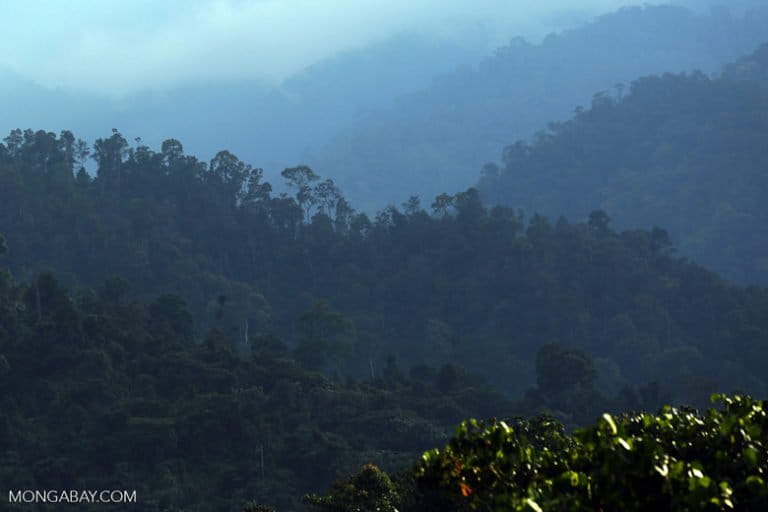- The number of wire snares being found in Sumatra’s Leuser Ecosystem has declined in recent years, but the traps continue to pose a severe threat to the region’s critically endangered rhinos.
- Poachers set the snares to catch anything ranging from wild boars for bushmeat to trophy animals — including the native Sumatran rhinos, elephants and tigers.
- Increased patrols have managed to reduce the numbers of snares found in Leuser, from 1,069 in 2016 to 241 in 2019.
- Conservationists say the Indonesian government must crack down harder on the entire supply chain of the illegal trade in Sumatran rhino parts, from poachers to buyers overseas.
BANDA ACEH, Indonesia — For the rhinos of Sumatra’s Leuser Ecosystem, snare traps set by poachers are a key factor that threatens to drive them closer to extinction.
The Leuser Ecosystem is one of the last refuges of the critically endangered Sumatran rhinoceros (Dicerorhinus sumatrensis). Fewer than 80 of the animals are believed to remain in the wild, isolated from one another in rapidly dwindling patches of rainforest in Indonesia’s Sumatra Island, with a handful thought to remain in Indonesian Borneo.
Leuser is home to one of the largest numbers of the species, split up across four habitats, which makes the area the most promising site for Sumatran rhino conservation. But wire snares set by illegal hunters to catch anything ranging from wild boars for bushmeat to trophy animals — including the native elephants and tigers — continue to pose an imminent threat to the rhinos.
“Elephants that are huge can be severely injured or even killed [by the traps], so imagine what will happen to the rhinos that are much smaller,” Rudi Putra, a biologist and chairman of the Leuser Conservation Forum’s (FKL) board of trustees, said in a recent webinar.

Recent studies have shown that snaring by hunters is a much more potent danger to the survival of Southeast Asia’s threatened wildlife compared to deforestation and forest degradation.
Snares are typically made of steel or nylon wire and are easy to build. They are also indiscriminate in what they catch, resulting in the capture of non-target species, as well as females and juvenile animals. While most of the trapped animals end up in local wildlife markets or are sold directly to restaurants as bushmeat, the high-value species are typically traded in major cities or exported to foreign markets.
Cracking down on the trade in Sumatran rhino body parts is very difficult, as smugglers operate closely and with great prudence, said Dwi N. Adhiasto, wildlife trade specialist at the organization Wildlife Crimes Unit (WCU). He said there were at least two syndicates in Indonesia known to poach rhinos and traffic their body parts to China and Vietnam, where they’re used in traditional medicine.
Dwi called in Indonesian conservation authorities and experts to clamp down on the entire supply chain, from the poachers on the ground to the buyers all around the world.
“The poachers must know the exact locations where the wildlife still remain that they want to capture, including rhinos,” Dwi said.
Rudi said there’s been a significant decline in snares recovered within Leuser in recent years, thanks to increased patrols by rangers and volunteers. The FKL removed or destroyed 1,069 snares from Leuser in 2016, and 241 in 2019. The traps were found throughout the ecosystem, from its core protected zone out to the logging areas on its periphery.
The Indonesian government has recently also pledged to enforce full protection of all Sumatran rhino habitats. A Sumatran rhino population that still records natural births in the wild, like the Leuser rhinos do, is crucial for the survival of the species. Many rhino experts say natural breeding can only happen when the animals feel safe enough to mate.
“We focus on deploying patrol teams all over the Leuser Ecosystem to protect the rhinos and other wildlife from poachers,” Rudi said. “But as long as snares are still set up in the forest, the rhinos will always be in danger.”

This story was first reported by Mongabay’s Indonesia team and published here on our Indonesian site on Sept. 29, 2020.
Banner image: Sumatran rhino at sanctuary in Way Kambas by Rhett Butler/Mongabay.
FEEDBACK: Use this form to send a message to the author of this post. If you want to post a public comment, you can do that at the bottom of the page.
